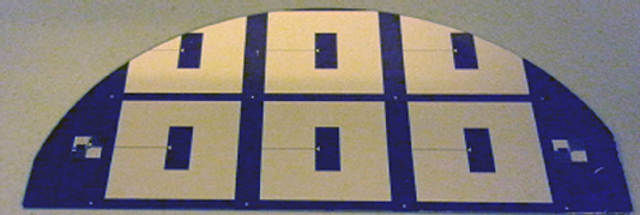Graphene antennae in the microwave part of the spectrum can be tuned by an applied voltage. This is the latest result, published in the renown physics journal Applied Physics Letters, by a pan-European collaboration between Romania, Greece, Italy, and Ireland, using Graphenea graphene.
High-frequency electronics is a complicated matter, due to giant losses that metals and most other conductors suffer at frequencies larger than several 10s of GHz. Electrons that oscillate rapidly experience a sort of friction with the conductor material itself, losing energy to heat.
 Graphene microwave antennae
Graphene microwave antennae
Graphene offers a different platform, in which electrons can oscillate quickly with little loss, due to the peculiar relativistic behavior of charge carriers in graphene. This advantage provided by graphene has resulted in transistors that operate at frequencies up to several terahertz (one terahertz is a thousand gigahertz).
In the microwave part of the spectrum, which is very important for communication, navigation, radar, and radio astronomy, researchers have been looking for the right material to make antennae which can be tuned with an external voltage. Advances have been made using exotic ferroelectrics, ferromagnetics, and liquid crystals, but all those materials, although allowing tunability, exhibited strong losses, preventing efficient microwave antennae.
Now researchers have demonstrated an antenna made from graphene, operating in the microwave part of the spectrum and tunable with external voltage. With a simple fabrication procedure and using a standard CVD graphene layer on a SOI substrate, the researchers show modulation of both the antenna efficiency and its operating frequency in the important X band, just by applying voltage. The antenna behavior is well described with standard microwave modelling tools, allowing for its use as part of more complex circuits.
The research also shows that the antenna, due to its small size compared to the centimeter-long wavelength in this frequency band, radiates in two directions, which could be useful or detrimental, depending on the application. Directionality can be controlled with an added thin reflector layer on the antenna back side. Overall the antenna is less than 1mm thin, with a planar diameter of 4 inches, making it one of the smallest microwave antennas in the world.
The authors of the paper predict that the main applications of this antenna lie in RF communication, where the antenna tunability will allow switching of communication channels. Working in reverse, the antenna could also serve as a radio frequency sensor. Radio frequency and terahertz applications will be among the most prominent uses of graphene, according to the Graphene Flagship application roadmap.